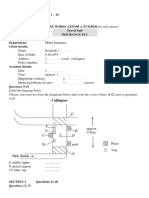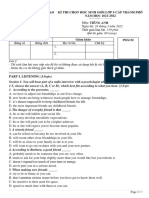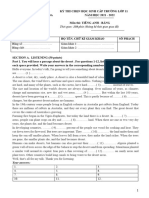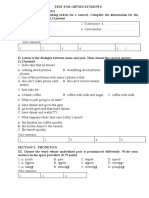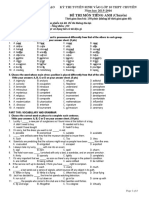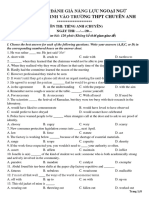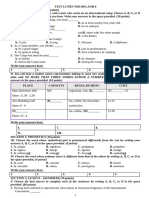Đề chính thức: (Đề gồm 13 trang) Thời gian: 150 phút (không kể thời gian giao đề)
Đề chính thức: (Đề gồm 13 trang) Thời gian: 150 phút (không kể thời gian giao đề)
Uploaded by
Mộc An KỳCopyright:
Available Formats
Đề chính thức: (Đề gồm 13 trang) Thời gian: 150 phút (không kể thời gian giao đề)
Đề chính thức: (Đề gồm 13 trang) Thời gian: 150 phút (không kể thời gian giao đề)
Uploaded by
Mộc An KỳOriginal Title
Copyright
Available Formats
Share this document
Did you find this document useful?
Is this content inappropriate?
Copyright:
Available Formats
Đề chính thức: (Đề gồm 13 trang) Thời gian: 150 phút (không kể thời gian giao đề)
Đề chính thức: (Đề gồm 13 trang) Thời gian: 150 phút (không kể thời gian giao đề)
Uploaded by
Mộc An KỳCopyright:
Available Formats
SỞ GIÁO DỤC VÀ ĐÀO TẠO KỲ THI CHỌN HỌC SINH GIỎI TỈNH LỚP 12
NGHỆ AN NĂM HỌC 2021 - 2022
Đề chính thức Môn thi: TIẾNG ANH - BẢNG A
Thời gian: 150 phút (không kể thời gian giao đề)
(Đề gồm 13 trang)
ĐIỂM HỌ TÊN, CHỮ KÍ GIÁM KHẢO SỐ PHÁCH
Bằng số: Giám khảo 1:
………………………………….. ………………………………………
Bằng chữ: ……………….. Giám khảo 2:
……………….... ………………………………………
Part 2. You will hear Stephanie who is thinking about taking a one-year course in children's
literature talking to Trevor who is currently taking the course. For question 16-25, choose the
correct answer (A, B, or C) which fits best according to what you hear. Write your answers in the
corresponding numbered boxes provided.
16. What does Trevor find interesting about the purpose of children's literature?
A. the fact that authors may not realise what values they're teaching
B. the fact that literature can be entertaining and educational at the same time
C. the fact that adults expect children to imitate characters in literature
17. Trevor says the module about the purpose of children's literature made him _________.
A. analyze some of the stories that his niece reads.
B. wonder how far popularity reflects good quality.
C. decide to start writing some children's stories.
18. Stephanie is interested in the Pictures module because _________.
A. she intends to become an illustrator.
B. she can remember beautiful illustrations from her childhood.
C. she believes illustrations are more important than words.
19. Trevor and Stephanie agree that comics _________.
A. are inferior to books.
B. have the potential for being useful.
C. discourage children from using their imagination.
20. With regard to books aimed at only boys or only girls, Trevor was surprised _________.
A. how long the distinction had gone unquestioned.
B. how few books were aimed at both girls and boys.
C. how many children enjoyed books intended for the opposite sex.
21. Perrault’s fairy tales _________.
A. were written in the 18th century
B. came out after “The Swiss Family Robinson”
C. started a new genre
22. What is true about “The Swiss Family Robinson”?
Tiếng Anh THPT – Bảng A 1
A. Its original title refers to another book.
B. Its name was changed into “Robinson Crusoe”.
C. Trever knew about its original title.
23. “The Nutcracker and the Mouse King” _________.
A. is the name of Tchaikovsky’s ballet
B. is full of usual details
C. inspired a work in a different area of art
24. Both Trevor and Stephanie are interested in _________.
A. Tchaikovsky’s ballet “The Nutcracker”
B. “The Happy Prince”
C. “The Lord of the Rings”
25. It can be understood that _________.
A. Stephanie finished reading two of the trilogies of “The Lord of the Rings”
B. Stephanie wasn’t patient enough to finish reading “The Lord of the Rings”
C. Trevor didn’t like “The Lord of the Rings”
Your answers:
16. 18. 20. 22. 24.
17. 19. 21. 23. 25.
SECTION B. LEXICO – GRAMMAR (20 points)
Part 1. Choose the best answer to complete each of the following sentences. Write A, B, C or D in
the corresponding numbered boxes.
1. Young herons are helpless for a few weeks _______ they learn to fly.
A. how B. before C. although D. since
2. We can rely on William to carry out the mission, for his judgment is always _______.
A. unquestionable B. delicate C. sound D. original
3. Let us hope that _______ a nuclear war, the human race still survives.
A. in relation to B. with reference to
C. in the event of D. within the realm of
4. Tommy is on the way to his friend’s birthday party, carrying a gift box _______ in colorful paper.
A. nicely wrapped B. having wrapped nicely
C. were nicely wrapped D. nicely wrapping
5. As a swarm of mosquitoes attacked them for hours _______, the enemy soldiers could no longer hold
on in their hiding place.
A. in the end B. no end C. without end D. on end
6. Attempts to help only _______ the problem so they were finally forced to call in the emergency
services.
A. extricated B. enervated C. extirpated D. exacerbated
7. Did you see John this morning? He looked like _______. It must have been quite a party last night.
A. death warmed up B. a bear with a sore head
C. a dead duck D. a wet blanket
8. We heard her _______ in agony as she dropped the saucepan on her toe.
A. boil over B. cry out C. let off D. ring out
9. _______ one after another, parallel computers perform groups of operations at the same time.
Tiếng Anh THPT – Bảng A 2
A. Conventional computers, by handling tasks
B. Since tasks being handled by conventional computers
C. Whereas conventional computers handle tasks
D. While tasks handled by conventional computers
Choose the correct answer A, B, C, or D to indicate the word(s) CLOSEST in meaning to the
underlined word(s) in each of the following questions.
10. Relaxation therapy teaches one not to fret over small problems.
A. worry about B. get angry about C. get involved in D. look for
Choose the correct answer A, B, C, or D to indicate the word(s) OPPOSITE in meaning to the
underlined word(s) in each of the following questions.
11. Getting an earnest apology from such a headstrong man like him was like getting blood out of a
stone.
A. out of the question B. contrary to reason
C. hundred-to-one D. a piece of cake
Choose the correct answer A, B, C, or D to indicate the sentence that best completes each of the
following exchanges
12. Jane: “I’ll do the washing-up, shall I?”
Tom: “__________________”
A. Kid’s stuff B. Ah, music to my ears
C. Not at all D. It’s a great pleasure
Your answers:
1. 3. 5. 7. 9. 11.
2. 4. 6. 8. 10. 12.
SECTION C. READING (70 points)
Part 1. Read the passage and choose the best answer. Write your answers A, B, C or D in the
corresponding numbered boxes.
MUSIC IN THE GREAT OUTDOORS
Outdoor entertainment has a long history in countries with a warm (1) _______. In ancient Greece,
for example, plays were (2) _______ in large open arenas. Today, audiences enjoy concerts of
classical, opera, pop and rock music in outdoor (3) _______. These are usually less formal and
restrictive for the listeners than a stuffy concert hall, and a warm, starry night (4) _______ a unique
atmosphere.
Music heard inside a building is (5) _______ to different acoustics. Sound vibrations are (6) _______
from a musical instrument or voice to the eardrum and the building’s structure can (7) _______ these
vibrations, which we then experience as an echo. Obstructions such as pillars can (8) _______
vibrations, and hard surfaces resonate or vibrate, (9) _______ the sound, while carpets and curtains
may (10) _______ and deaden voices and music.
The music at open-air concerts, on the other hand, must often compete (11) _______ the noise of traffic,
bird song or wind and thunder. A (12) _______ wind can carry the sound away and a sudden
summer storm can drown out the music altogether. In addition, if there is any (13) _______ of rain, all
instruments and sound equipment must be housed under (14) _______ to avoid the danger of
Tiếng Anh THPT – Bảng A 3
electrocution. Once these problems are (15) _______, outdoor concerts allow people the
opportunity to enjoy a wide range of live music in the fresh air.
1. A. season B. weather C. climate D. condition
2. A. performed B. shown C. executed D. held
3. A. localities B. circumstances C. surroundings D. backgrounds
4. A. builds B. forms C. composes D. creates
5. A. liable B. subject C. related D. adapted
6. A. transmitted B. played C. directed D. broadcast
7. A. reflect B. exhibit C. produce D. register
8. A. harm B. halt C. impede D. prevent
9. A. twisting B. bending C. distorting D. adjusting
10. A. absorb B. attract C. withdraw D. detain
11. A. on B. for C. at D. with
12. A. firm B. strong C. forceful D. rough
13. A. damage B. risk C. threat D. danger
14. A. enclosure B. shade C. wrapper D. cover
15. A. defeated B. overcome C. cleared D. handled
Your answers:
1. 4. 7. 10. 13.
2. 5. 8. 11. 14.
3. 6. 9. 12. 15.
Part 2. Fill in the gap with ONE suitable word. Write the answers in the corresponding numbered
boxes.
LIVING IN SPACE
We are living at a critical point in our history. Once upon a time primitive people feared storms and the
night, and lived by superstitions. Then science rationalised things and created order, and (16) _______
us to the point where we could invent theories of creation and test (17) _______ in the laboratory. We
began to feel omnipotent. We were aware that (18) _______ were man-made threats which could wipe
us off the (19) _______ of the Earth. But the Universe would go on for ever. Now we are not (20)
_______ sure. We are becoming increasingly aware (21) _______ our vulnerability, and so far, have
done very (22) _______ about it. With planning we (23) _______, one day, escape the Earth and
colonise space. After (24) _______, transatlantic flight is commonplace today but would have been (25)
_______ a dream in Columbus' time, five hundred years ago.
More than a few scientists believe that mankind's arrival is so improbable (26) _______ it is as if Nature
conspired to bring it about. They see hints that the Universe created life to be its agents for immortality.
As (27) _______ as we know, we are the ones (28) _______ have to carry out the task. If we can (29)
_______ extinction in the short term, then we may propagate throughout space into the indefinite future.
You and I have no right to life; we inherited it by chance. Now that we are here, we have the duty to
(30) _______ our part in the great human relay race.
Your answers:
16. 19. 22. 25. 28.
17. 20. 23 26. 29.
18. 21. 24. 27. 30.
Tiếng Anh THPT – Bảng A 4
Part 3. Read the following passage and choose the correct answer to each of the questions. Write
your answers A, B, C or D in the corresponding numbered boxes.
Before 1815 manufacturing in the United States had been done in homes or shops by skilled artisans.
As master craft workers, they imparted the knowledge of their trades to apprentices and journeymen. In
addition, women often worked in their homes part-time, making finished articles from raw material
supplied by merchant capitalists. After 1815 this older form of manufacturing began to give way to
factories with machinery tended by unskilled or semiskilled laborers. Cheap transportation networks, the
rise of cities, and the availability of capital and credit all stimulated the shift to factory production.
The creation of a labor force that was accustomed to working in factories did not occur easily. Before
the rise of the factory, artisans had worked within the home. Apprentices were considered part of the
family, and masters were responsible not only for teaching their apprentices a trade but also for
providing them some education and for supervising their moral behavior. Journeymen knew that if
they perfected their skill, they could become respected master artisans with their own shops. Also,
skilled artisans did not work by the clock, at a steady pace, but rather in bursts of intense labor
alternating with more leisurely time.
The factory changed that. Goods produced by factories were not as finished or elegant as those done
by hand, and pride in craftsmanship gave way to the pressure to increase rates of productivity. The new
methods of doing business involved a new and stricter sense of time. Factory life necessitated a more
regimented schedule, where work began at the sound of a bell and workers kept machines going at a
constant pace. At the same time, workers were required to discard old habits, for industrialism
demanded a worker who was alert, dependable, and self-disciplined. Absenteeism and lateness hurt
productivity and, since work was specialized, disrupted the regular factory routine. Industrialization not
only produced a fundamental change in the way work was organized; it transformed the very nature of
work.
The first generation to experience these changes did not adopt the new attitudes easily. The factory
clock became the symbol of the new work rules. One mill worker who finally quit complained
revealingly about "obedience to the ding-dong of the bell—just as though we are so many living
machines." With the loss of personal freedom also came the loss of standing in the community. Unlike
artisan workshops in which apprentices worked closely with the masters supervising them, factories
sharply separated workers from management. Few workers rose through the ranks to supervisory
positions, and even fewer could achieve the artisan's dream of setting up one's own business. Even well-
paid workers sensed their decline in status.
In this newly emerging economic order, workers sometimes organized to protect their rights and
traditional ways of life. Craftworkers such as carpenters, printers, and tailors formed unions, and in 1834
individual unions came together in the National Trades' Union. The labor movement gathered some
momentum in the decade before the Panic of 1837, but in the depression that followed, labor's strength
collapsed. During hard times, few workers were willing to strike or engage in collective action. And
skilled craftworkers, who spearheaded the union movement, did not feel a particularly strong bond with
semiskilled factory workers and unskilled laborers. More than a decade of agitation did finally bring a
workday shortened to 10 hours to most industries by the 1850s, and the courts also recognized workers'
right to strike, but these gains had little immediate impact.
Workers were united in resenting the industrial system and their loss of status, but they were divided
by ethnic and racial antagonisms, gender, conflicting religious perspectives, occupational differences,
political party loyalties and disagreements over tactics. For them, the factory and industrialism were
Tiếng Anh THPT – Bảng A 5
not agents of opportunity but reminders of their loss of independence and a measure of control over their
lives. As United States society became more specialized and differentiated, greater extremes of wealth
began to appear. And as the new markets created fortunes for the few, the factory system lowered the
wages of workers by dividing labor into smaller, less skilled tasks.
31. Which of the following can be inferred from the passage 1 about articles manufactured before 1815?
A. They were primarily produced by women.
B. They were generally produced in shops rather than in homes.
C. They were produced with more concern for quality than for speed of production.
D. They were produced mostly in large cities with extensive transportation networks.
32. Which of the sentences below best expresses the essential information in the highlighted sentence in
the passage 2? Incorrect answer choices change the meaning in important ways or leave out essential
information.
A. Masters demanded moral behavior from apprentices but often treated them irresponsibly.
B. The responsibilities of the master to the apprentice went beyond the teaching of a trade.
C. Masters preferred to maintain the trade within the family by supervising and educating the
younger family members.
D. Masters who trained members of their own family as apprentices demanded excellence from them.
33. The word "disrupted" in the passage 3 is closest in meaning to _______.
A. prolonged B. established C. followed D. upset
34. In paragraph 4, the author includes the quotation from a mill worker in order to _______.
A. support the idea that it was difficult for workers to adjust to working in factories
B. to show that workers sometimes quit because of the loud noise made by factory machinery
C. argue that clocks did not have a useful function in factories
D. emphasize that factories were most successful when workers revealed their complaints
35. All of the following are mentioned in paragraph 4 as consequences of the new system for workers
EXCEPT a loss of _______.
A. freedom B. status in the community
С. opportunities for advancement D. contact among workers who were not managers
36. The phrase "gathered some momentum" in the passage 5 is closest in meaning to _______.
A. made progress B. became active
C. caused changes D. combined forces
37. The word "spearheaded" in the passage 5 is closest in meaning to _______.
A. led B. accepted C. changed D. resisted
38. Which of the following statements about the labor movement of the 1800’s is supported by
paragraph 5?
A. It was most successful during times of economic crisis.
B. Its primary purpose was to benefit unskilled laborers.
C. It was slow to improve conditions for workers.
D. It helped workers of all skill levels form a strong bond with each year
39. The author identifies political party loyalties and disagreements over tactics as two of several
factors that _______.
A. encouraged workers to demand higher wages
B. created divisions among workers
C. caused work to become more specialized
Tiếng Anh THPT – Bảng A 6
D. increased workers' resentment of the industrial system
40. The word "them" in the passage 6 refers to _______.
A. workers B. political party loyalties
C. disagreements over tactics D. agents of opportunity
Your answers:
31. 33. 35. 37. 39.
32. 34. 36. 38. 40.
Part 4. The reading passage has eight paragraphs, A-H. Choose the correct heading for
paragraphs B-G from the list of headings below. Write your answers A, B, C or D in the
corresponding numbered boxes.
BILINGUALISM IN CHILDREN
A. One misguided legacy of over a hundred years of writing on bilingualism is that children’s
intelligence will suffer if they are bilingual. Some of the earliest research into bilingualism examined
whether bilingual children were ahead or behind monolingual children on IQ tests. From the 1920s
through to the 1960s, the tendency was to find monolingual children ahead of bilinguals on IQ tests. The
conclusion was that bilingual children were mentally confused. Having two languages in the brain, it
was said, disrupted effective thinking. It was argued that having one well-developed language was
superior to having two half-developed languages.
B. The idea that bilinguals may have a lower IQ still exists among many people, particularly
monolinguals. However, we now know that this early research was misconceived and incorrect. First,
such research often gave bilinguals an IQ test in their weaker language – usually English. Had bilinguals
been tested in Welsh or Spanish or Hebrew, a different result may have been found. The testing of
bilinguals was thus unfair. Second, like was not compared with like. Bilinguals tended to come from, for
example, impoverished New York or rural Welsh backgrounds. The monolinguals tended to come from
a more middle-class, urban families. Working-class bilinguals were often compared with middle-class
monolinguals. So, the results were more likely to be due to social class differences than language
differences. The comparison of monolinguals and bilinguals was unfair.
C. The most recent research from Canada, the United States, and Wales suggests that bilinguals are, at
least, equal to monolinguals on IQ tests. When bilinguals have two well-developed languages (in the
research literature called balanced bilinguals), bilinguals tend to show a slight superiority in IQ tests
compared with monolinguals. This is the received psychological wisdom of the moment and is good
news for raising bilingual children. Take, for example, a child who can operate in either language in the
curriculum in the school. That child is likely to be ahead on IQ tests compared with similar (same
gender, social class and age) monolinguals. Far from making people mentally confused, bilingualism is
now associated with a mild degree of intellectual superiority.
D. One note of caution needs to be sounded. IQ tests probably do not measure intelligence. IQ tests
measure a small sample of the broadest concept of intelligence. IQ tests are simply paper and pencil tests
where only ‘right and wrong’ answers are allowed. Is all intelligence summed up in such right and
wrong, pencil and paper tests? Isn’t there a wider variety of intelligences that are important in everyday
functioning and everyday life?
E. Many questions need answering. Do we only define an intelligent person as somebody who obtains a
high score on an IQ test? Are the only intelligent people those who belong to high IQ organizations such
Tiếng Anh THPT – Bảng A 7
as MENSA? Is there social intelligence, musical intelligence, military intelligence, marketing
intelligence, motoring intelligence, political intelligence? Are all, or indeed any, of these forms of
intelligence measured by a simple pencil and paper IQ test which demands a single, acceptable, correct
solution to each question? Defining what constitutes intelligent behavior requires a personal value
judgement as to what type of behavior, and what kind of person is of more worth.
F. The current state of psychological wisdom about bilingual children is that, where two languages are
relatively well developed, bilinguals have thinking advantages over monolinguals. Take an example. A
child is asked a simple question: How many uses can you think of for a brick? Some children give two
or three answers only. They can think of building walls, building a house and perhaps that is all. Another
child scribbles away, pouring out ideas one after the other: blocking up a rabbit hole, breaking a
window, using as a bird bath, as a plumb line, as an abstract sculpture in an art exhibition.
G. Research across different continents of the world shows that bilinguals tend to be more fluent,
flexible, original and elaborate in their answers to this type of open-ended question. The person who can
think of a few answers tends to be termed a convergent thinker. They converge onto a few acceptable
conventional answers. People who think of lots of different uses for unusual items (e.g. a brick, tin can,
cardboard box) are called divergers. Divergers like a variety of answers to a question and are
imaginative and fluent in their thinking.
H. There are other dimensions in thinking where approximately ‘balanced’ bilinguals may have
temporary and occasionally permanent advantages over monolinguals: increased sensitivity to
communication, a slightly speedier movement through the stages of cognitive development, and being
less fixed on the sounds of words and more centered on the meaning of words. Such ability to move
away from the sound of words and fix on the meaning of words tends to be a (temporary) advantage for
bilinguals around the ages four to six. This advantage may mean an initial head start in learning to read
and learning to think about language.
LIST OF HEADINGS
i No single definition of intelligence
ii Faulty testing, wrong conclusion
iii Welsh research supports IQ testing
iv Beware: inadequate for testing intelligence
v International research supports bilingualism
vi Current thought on the advantage bilinguals have
vii Early beliefs regarding bilingualism
viii Monolinguals ahead of their bilingual peers
ix Exemplifying the bilingual advantage
Your answers:
41. Paragraph B ______ 43. Paragraph D ______ 45. Paragraph F ______
42. Paragraph C ______ 44. Paragraph E ______ 46. Paragraph G ______
Questions 47-50
Do the following statements agree with the information given in Reading Passage? Write
TRUE, if the statement agrees with the information
Tiếng Anh THPT – Bảng A 8
FALSE, if the statement contradicts the information
NOT GIVEN, if there is no information on this
47. Balanced bilinguals have more permanent than temporary advantages over monolinguals.
48. Often bilinguals concentrate more on the way a word sounds than on its meaning.
49. Monolinguals learn to speak at a younger age than bilinguals.
50. Bilinguals just starting school might pick up certain skills faster than monolinguals.
Your answers:
47. ______ 48. ______ 49. ______ 50. ______
SECTION D. WRITING (60 points)
Part 1. Complete the second sentence so that it has the same meaning as the first one. Use the
word given in capital letters and the word mustn’t be altered in any way.
1. Malcolm had to stay in prison until the trial came to a definite end. RELEASED
Only after the trial _______________________________________________ from prison.
2. I promised her that the situation would not be repeated in the future. WORD
I _______________________________________________ no repetition of the situation in the future.
3. He was annoyed because his secretary came late to work. COMING
He objected _____________________________________________________ to work.
4. Tom’s presence at parties adds to everyone’s enjoyment. SOUL
Tom ___________________________________________________________ parties.
5. His colleague will do anything to avoid confrontation. LENGTHS
His colleague ____________________________________________________ to avoid confrontation.
Tiếng Anh THPT – Bảng A 9
You might also like
- PADER Form (Form1) - UpdatedDocument8 pagesPADER Form (Form1) - UpdatedSrinivas EtikalaNo ratings yet
- Maths - No Problem Multiplication and Division, Ages 9-10 (Key Stage 2) (Maths - No Problem)Document50 pagesMaths - No Problem Multiplication and Division, Ages 9-10 (Key Stage 2) (Maths - No Problem)morenodlt100% (2)
- (2021-2022) (HSG 12 TPHCM) (With Official Key + Comments)Document7 pages(2021-2022) (HSG 12 TPHCM) (With Official Key + Comments)William PhoenixNo ratings yet
- Revision For The 1ST Mid-Term Test - Grade 12 - HSDocument5 pagesRevision For The 1ST Mid-Term Test - Grade 12 - HS12. Ngọc HânNo ratings yet
- Complete The Form Below Write No More Than Three Words And/Or A Number For Each AnswerDocument6 pagesComplete The Form Below Write No More Than Three Words And/Or A Number For Each AnswerMộc An KỳNo ratings yet
- Homework Solution, Modern - Mathematical.Statistics - With.applicationDocument3 pagesHomework Solution, Modern - Mathematical.Statistics - With.applicationviviancruise0% (2)
- Practical Experience LogbookDocument6 pagesPractical Experience Logbookng soo keeNo ratings yet
- ĐỀ HSG CỤM LỚP 10 CHÍNH THỨCDocument10 pagesĐỀ HSG CỤM LỚP 10 CHÍNH THỨCPhuongg Linh VuNo ratings yet
- SỞ GDDocument13 pagesSỞ GDtuananhnguyendinh721No ratings yet
- Anh CT1Document9 pagesAnh CT1thaonguyenwind100% (1)
- SAMPLE TEST 10 Thi TH Vào 10Document5 pagesSAMPLE TEST 10 Thi TH Vào 10n.ngminh03No ratings yet
- ĐỀ THI HSG LƠP 11 THAI HÒA 2021-2022Document11 pagesĐỀ THI HSG LƠP 11 THAI HÒA 2021-2022thuchungnguyen83No ratings yet
- 2016 - Chuyên Trần PhúDocument20 pages2016 - Chuyên Trần PhúRoland VietnamNo ratings yet
- Test For Gifted StudentsDocument7 pagesTest For Gifted StudentsTrần DũngNo ratings yet
- ĐỀ - HSG 8 - 1Document9 pagesĐỀ - HSG 8 - 1Tiếng Anh 7No ratings yet
- 101 Anh10 HK2 2015 2016Document5 pages101 Anh10 HK2 2015 2016tuantu_51No ratings yet
- 10 de HSG Tap 1Document135 pages10 de HSG Tap 1Ly BùiNo ratings yet
- HSG TỈNH BẮC NINHDocument12 pagesHSG TỈNH BẮC NINHheavyxxx1234No ratings yet
- Sở Giáo Dục Và Đào Tạo Vĩnh Phúc Trường Thpt Chuyên Vĩnh Phúc (Đềthigồm 5trang) Đề Kscl Các Môn Thi Thpt Quốc Gia - Lần 2 NĂM HỌC: 2020-2021 Môn: Anh 11Document6 pagesSở Giáo Dục Và Đào Tạo Vĩnh Phúc Trường Thpt Chuyên Vĩnh Phúc (Đềthigồm 5trang) Đề Kscl Các Môn Thi Thpt Quốc Gia - Lần 2 NĂM HỌC: 2020-2021 Môn: Anh 11lienanhcvpNo ratings yet
- 2017 de Chinh Thuc HSGDocument12 pages2017 de Chinh Thuc HSGOliviaLeeNo ratings yet
- Test 12Document3 pagesTest 12Trần Quỳnh NhưNo ratings yet
- De Thi Vao Lop 10 Mon Tieng Anh Chuyen Truong THPT Chuyen Tran Phu Hai Phong Nam 2015Document6 pagesDe Thi Vao Lop 10 Mon Tieng Anh Chuyen Truong THPT Chuyen Tran Phu Hai Phong Nam 2015Thắng NguyễnNo ratings yet
- A. Listening (3.0 points) : Đề Tự Luyện Số 1Document6 pagesA. Listening (3.0 points) : Đề Tự Luyện Số 1Đỗ LinhNo ratings yet
- HSG 12-TPHCM 21-22Document5 pagesHSG 12-TPHCM 21-22thuba71No ratings yet
- Test 67Document2 pagesTest 67dauphongclgtNo ratings yet
- Đề thi chọn học sinh giỏi lớp 12 THPT cấp thành phố (TP HCM) năm học 2021-2022Document7 pagesĐề thi chọn học sinh giỏi lớp 12 THPT cấp thành phố (TP HCM) năm học 2021-2022Tuanhung NguyenNo ratings yet
- ĐỀ GIỚI THIỆU HSG 10- 23Document12 pagesĐỀ GIỚI THIỆU HSG 10- 23kimnhung0209No ratings yet
- Đề thi học sinh giỏi môn Tiếng Anh lớp 10 cấp trường năm 2020-2021 có đáp án - Trường THPT Liễn Sơn, Vĩnh Phúc (download tai tailieutuoi.com)Document7 pagesĐề thi học sinh giỏi môn Tiếng Anh lớp 10 cấp trường năm 2020-2021 có đáp án - Trường THPT Liễn Sơn, Vĩnh Phúc (download tai tailieutuoi.com)Nhữ NhiNo ratings yet
- De Thi HSG Chinh ThucDocument12 pagesDe Thi HSG Chinh ThuchahaNo ratings yet
- Đề 2402 - Đề ôn thi THPT QG 2024 - thứ 3 (tuần 17 - 06 - 23 - 06)Document10 pagesĐề 2402 - Đề ôn thi THPT QG 2024 - thứ 3 (tuần 17 - 06 - 23 - 06)hang nguyenNo ratings yet
- Đề thi thử vào lớp 10 số 41Document4 pagesĐề thi thử vào lớp 10 số 41Thinh LuongNo ratings yet
- Test 12Document3 pagesTest 12phuonganh14032910No ratings yet
- A7 yl 1819Document8 pagesA7 yl 1819ngongocha3002No ratings yet
- Luyen HSG 9 3Document4 pagesLuyen HSG 9 3nguyenvunhathuy.tailieuhoctap1No ratings yet
- Đề chuyên Anh Bắc Ninh vào 10 năm 2024 2025Document10 pagesĐề chuyên Anh Bắc Ninh vào 10 năm 2024 2025Nguyen Ngoc DungNo ratings yet
- ĐỀ THI TIẾNG ANHDocument5 pagesĐỀ THI TIẾNG ANHestudy065No ratings yet
- Test 12 HSDocument5 pagesTest 12 HSNguyễn Nguyệt MinhNo ratings yet
- Review 2 9 2021Document8 pagesReview 2 9 2021Trâm Đặng Cao NgọcNo ratings yet
- Khu Vuc Duyen Hai 11 WORDDocument12 pagesKhu Vuc Duyen Hai 11 WORDTracyNo ratings yet
- Test Yourself 1Document9 pagesTest Yourself 1Trần LinhNo ratings yet
- QUYẾT CHIẾN 7Document6 pagesQUYẾT CHIẾN 7Khánh ThoaNo ratings yet
- Đề Luyện Vào 10 Số 8Document5 pagesĐề Luyện Vào 10 Số 82024 - Lê Thị Thu HằngNo ratings yet
- Lop 8 Thanh Pho 21-22Document5 pagesLop 8 Thanh Pho 21-22tran thi phuong linhNo ratings yet
- De HP NĂM TruocDocument30 pagesDe HP NĂM Truochuynhnguyenhp040No ratings yet
- đề anh số 3Document4 pagesđề anh số 3Đỗ LinhNo ratings yet
- Đề Hsnk Tiếng Anh 8 Thcs Đông Phương Yên (2022 - 2023)Document10 pagesĐề Hsnk Tiếng Anh 8 Thcs Đông Phương Yên (2022 - 2023)caubeoccho112No ratings yet
- 2018年上海高考春季英语真题试卷Document16 pages2018年上海高考春季英语真题试卷stellalan0222No ratings yet
- Đề Thi Thử Đánh Giá Năng Lực Ngoại NgữDocument8 pagesĐề Thi Thử Đánh Giá Năng Lực Ngoại NgữhongggggggNo ratings yet
- 08. ĐỀ SỐ 08 HSG ANH 8 (HUYỆN)Document7 pages08. ĐỀ SỐ 08 HSG ANH 8 (HUYỆN)cxk98ngoc0208No ratings yet
- đang sửa đề 1Document7 pagesđang sửa đề 1linhhkhanhh.workingNo ratings yet
- Thời gian: 150 phút (không kể thời gian giao đề)Document86 pagesThời gian: 150 phút (không kể thời gian giao đề)Nguyễn Hoàng Công MinhNo ratings yet
- Assorted Test 8Document5 pagesAssorted Test 8Dũng TuấnNo ratings yet
- Anh SơnDocument4 pagesAnh Sơnphuonggchi74No ratings yet
- Practice Test 3Document4 pagesPractice Test 3Hiếu Nguyễn MinhNo ratings yet
- ĐỀ KSCLHSG TIẾNG ANH 12 LẦN 1Document12 pagesĐỀ KSCLHSG TIẾNG ANH 12 LẦN 1Bao Anh TrầnNo ratings yet
- Đề thi thử lần 1Document6 pagesĐề thi thử lần 1Hòa TrầnNo ratings yet
- De Chon Doi Tuyen Chinh Thuc 19.1.24Document10 pagesDe Chon Doi Tuyen Chinh Thuc 19.1.24Thư NguyễnNo ratings yet
- Practice Test 28-7Document5 pagesPractice Test 28-7Mon MonNo ratings yet
- Đề 2 thi thử Tiếng Anh 9 23-24Document4 pagesĐề 2 thi thử Tiếng Anh 9 23-24Mai Anh Vi HàNo ratings yet
- Trung Hiếu 7CDocument7 pagesTrung Hiếu 7Ctrantrunghieu200411No ratings yet
- 08 - Test Ôn Thi Hsg Anh 9 - Tuần 7 - Tháng 10 - 2024 (1)Document8 pages08 - Test Ôn Thi Hsg Anh 9 - Tuần 7 - Tháng 10 - 2024 (1)linhchi.nx2010No ratings yet
- Practice Test 056.2020Document8 pagesPractice Test 056.202010: Lê Minh Hiển:8a1No ratings yet
- Practices Test 1Document4 pagesPractices Test 1trinmNo ratings yet
- Đề chính thức: (Đề gồm 13 trang) Thời gian: 150 phút (không kể thời gian giao đề)Document14 pagesĐề chính thức: (Đề gồm 13 trang) Thời gian: 150 phút (không kể thời gian giao đề)Mộc An KỳNo ratings yet
- Question 1. Finish Each of The Following Sentences in Such A Way That It Means The Same As The Sentence Printed Before It. (5 PT)Document28 pagesQuestion 1. Finish Each of The Following Sentences in Such A Way That It Means The Same As The Sentence Printed Before It. (5 PT)Mộc An KỳNo ratings yet
- 100 Cau StressDocument1 page100 Cau StressMộc An KỳNo ratings yet
- (không kể thời gian giao đề) (Đề này có 08 trang)Document9 pages(không kể thời gian giao đề) (Đề này có 08 trang)Mộc An KỳNo ratings yet
- (123doc) de Thi HSG Anh 8 2016 Cap Tinh Chinh ThucDocument9 pages(123doc) de Thi HSG Anh 8 2016 Cap Tinh Chinh ThucMộc An KỳNo ratings yet
- Directions Sense Quiz 13Document16 pagesDirections Sense Quiz 13singhNo ratings yet
- Jane Eyre in No Telephone To HeavenDocument6 pagesJane Eyre in No Telephone To HeavenEric EmerNo ratings yet
- Hypothesis Testing FinalDocument14 pagesHypothesis Testing FinalDhruvin SakariyaNo ratings yet
- Dissertation Gender DiversityDocument5 pagesDissertation Gender DiversityCustomPapersWritingMilwaukee100% (1)
- In-Text CitationDocument4 pagesIn-Text CitationIbrahim HasanNo ratings yet
- World Heritage WatchDocument251 pagesWorld Heritage WatchbraunzinhoNo ratings yet
- University of Jammu: Faculty of Arts / Social Science / Science / Commerce & Management Time: - 10: 00 AMDocument2 pagesUniversity of Jammu: Faculty of Arts / Social Science / Science / Commerce & Management Time: - 10: 00 AMPoint BreakNo ratings yet
- ESS Core Questionnaire Socio Political OrientationsDocument26 pagesESS Core Questionnaire Socio Political OrientationsMaxNo ratings yet
- Register of Entities Associated With Asean Updated List of Entities Associated With ASEAN On ASEAN WebsiteDocument49 pagesRegister of Entities Associated With Asean Updated List of Entities Associated With ASEAN On ASEAN WebsiteLiam KimNo ratings yet
- Block Diagrams & Signal Flow GraphsDocument47 pagesBlock Diagrams & Signal Flow GraphsMacky Pogi02No ratings yet
- Conceptual Overview of Human Development Definitions, Critiques, and Related Concepts. OPHIDocument35 pagesConceptual Overview of Human Development Definitions, Critiques, and Related Concepts. OPHILorena ArayaNo ratings yet
- Jyothish Kumar Took Sulphur Powder On A Spatula and Heated It. HeDocument9 pagesJyothish Kumar Took Sulphur Powder On A Spatula and Heated It. HeSharan SiuuNo ratings yet
- Lesson+6+ +Intersubjective+Human+RelationsDocument5 pagesLesson+6+ +Intersubjective+Human+RelationsRachelle anne Bagaporo100% (2)
- Tiny Frontiers - Rules ExpansionDocument6 pagesTiny Frontiers - Rules ExpansionSekcerNo ratings yet
- 20200929082824-KI EN10025 2020 Rev1 enDocument7 pages20200929082824-KI EN10025 2020 Rev1 enhelderfsnNo ratings yet
- Control Systems Engineering MCQDocument74 pagesControl Systems Engineering MCQformyphdNo ratings yet
- Centre of Mass and Rigidity Story Diaphragm Mass X Mass Y XCM Ycm XCCM Yccm XCR Ycr KG KG M M KG KG M M M M Cumulative X Cumulati VeyDocument7 pagesCentre of Mass and Rigidity Story Diaphragm Mass X Mass Y XCM Ycm XCCM Yccm XCR Ycr KG KG M M KG KG M M M M Cumulative X Cumulati VeyRakesh ShresthaNo ratings yet
- Benchmarking The Collocation Stand-Alone Library and Toolkit (CSALT)Document7 pagesBenchmarking The Collocation Stand-Alone Library and Toolkit (CSALT)Yandex TagarNo ratings yet
- Class Program: Division of Sarangani San Roque National High SchoolDocument2 pagesClass Program: Division of Sarangani San Roque National High SchoolCherryl GuladaNo ratings yet
- 9. ĐỀ T ANH 11Document8 pages9. ĐỀ T ANH 11testhackafsNo ratings yet
- FlukeDocument4 pagesFlukeFlorin PetreNo ratings yet
- SSUA EPE (September, 2018) - 0Document34 pagesSSUA EPE (September, 2018) - 0Daviid MalavertNo ratings yet
- Issue 92Document118 pagesIssue 92rosenblumtamala.bmbl.45.45No ratings yet
- Inner Circle Trader - Sniper Course, Boot CampDocument1 pageInner Circle Trader - Sniper Course, Boot CampJeff Thamani SamNo ratings yet
- Plane Shift - Thunder Junction - The HomebreweryDocument53 pagesPlane Shift - Thunder Junction - The HomebreweryJoão OttNo ratings yet
- Production ChemistDocument2 pagesProduction Chemistapi-122049623No ratings yet





